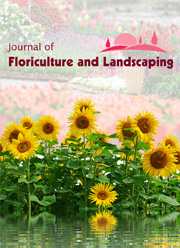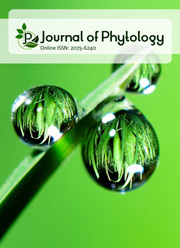Plant chimera and its management for the floriculture industry
DOI:
https://doi.org/10.25081/jfcls.2025.v11.9568Keywords:
Bud sport, Induced mutation, Chimera, Management, New variety, FloricultureAbstract
In the floriculture industry, there is always a demand and necessity for new varieties. This industry has prospered due to science-based techniques and a steady supply of improved plant materials and new varieties. A massive amount of literature has been accumulated on developing new ornamental varieties. Bud sports and induced mutations are well-established methods for crop improvement and have played a major role in developing many new flower color/shape mutant varieties in ornamentals. But the main bottleneck is that in both the methods mutation appears as a chimera and isolation of such chimeras is a great challenge. The use of plant chimera in the floriculture industry is an ancient but innovative subject. A novel in vitro technique (tissue culture) has been standardized for managing such chimeric tissues through direct shoot regeneration. The prime intention of this write-up is to evaluate management techniques for chimera to develop new varieties for the floriculture trade. The technique will enrich the floriculture industry with new varieties through the retrieval of chimeric tissues.
Downloads
References
Barakat, M. N., & El-Sammak, H. (2011). In vitro mutagenesis, plant regeneration, and characterization of mutants via RAPD analysis in baby’s breath Gypsophila paniculata L. Australian Journal of Crop Science, 5(2), 214-222.
Broertjes, C., & van Harten, A. M. (1988). Applied Mutation Breeding for Vegetatively propagated Crops. (1st ed.). Amsterdam, Netherlands: Elsevier.
Chakrabarty, D., Mandal, A. K. A., & Datta, S. K. (1999). Management of chimera through direct Shoot regeneration from florets of chrysanthemum (Chrysanthemum morifolium Ramat). The Journal of Horticultural Science and Biotechnology, 74(3), 293-296. https://doi.org/10.1080/14620316.1999.11511111
Chakrabarty, D., Mandal, A. K., & Datta, S. K. (2000). Retrieval of new coloured chrysanthemum through organogenesis from sectorial chimeras. Current Science, 78(9), 1060-1061.
Darwin, C. (1968). Variation of Animals and Plants under domestication. Parts I, II. London, UK: Murray.
Datta, S. K. (2009). Plant chimeras and their role in the development of new ornamental varieties. Journal of Ornamental Horticulture, 12(2), 75-94.
Datta, S. K. (2015). Indian Floriculture; Role of CSIR. New Delhi, India: Regency Publications, A Division of Astral International(P) Ltd..
Datta, S. K. (2018). Breeding of new ornamental varieties: Rose. Current Science, 114(6), 1194-1206.
Datta, S. K. (2020). Induced mutations: technological advancement for the development of new ornamental varieties. The Nucleus, 63, 119-129. https://doi.org/10.1007/s13237-020-00310-7
Datta, S. K. (2021). Breeding of ornamentals: success and technological status. The Nucleus, 65, 107-128. https://doi.org/10.1007/s13237-021-00368-x
Datta, S. K. (2023a). Induced Mutation Breeding. Singapore: Springer.
Datta, S. K. (2023b). Role of Mutation Breeding in the Floriculture Industry. Singapore: Springer.
Datta, S. K. (2023c). Technology Package for Induced Mutagenesis. Journal of Biology and Nature, 15(1), 70-88. https://doi.org/10.56557/joban/2023/v15i18077
Datta, S. K. (2024). Literature survey and futuristic research approach on floriculture: Bougainvillea. Discover Plants, 1, 25. https://doi.org/10.1007/s44372-024-00026-x
Datta, S. K., & Chakrabarty, D. (2009). Management of chimera and in vitro mutagenesis for development of new flower colour/shape and chlorophyll variegated mutants in Chrysanthemum. In Q. Y. Shu (Ed.), Induced Plant Mutations in the Genomics Era (pp. 303-305). Vienna, Austria: Joint FAO/IAEA Division of Nuclear Techniques in Food and Agriculture, International Atomic Energy Agency.
Datta, S. K., & Shukla, R. (1996). Effects of gamma irradiation on mutants of Tuberose (Polyanthes tuberosa). Herbertia, 59, 139-141.
Datta, S. K., Chakraborty, D., Mandal, A. K. A. (2001). Gamma ray-induced genetic manipulations in flower colour and shape in Dendranthema grandiflorum and their management through tissue culture. Plant Breeding, 120(1), 91-92. https://doi.org/10.1046/j.1439-0523.2001.00553.x
Datta, S. K., Mishra, P., & Mandal, A. K. A. (2005). In vitro mutagenesis - a quick method for the establishment of solid mutants in chrysanthemum. Current Science, 88(1), 155-158.
Din, A., Qadri, Z. A., Wani, M. A., Rather, Z. A., Iqbal, S., Malik, S. A., Rafiq, S., & Nazki, I. T. (2021). Congenial in Vitro γ-Ray Induced Mutagenesis Underlying the Varied Array of Petal Colours in Chrysanthemum (Dendranthemum Grandiflorum Kitam). ‘Candid’. Research Square. https://doi.org/10.21203/rs.3.rs-617238/v1
Dwivedi, A. K., Banerji, B. K., Chakraborty, D., Mandal, A. K. A., & Datta, S. K. (2002). Gamma-ray induced new flower colour chimera and its management through tissue culture. Indian Journal of Agricultural Sciences, 70(12), 853-855.
Grant, V. (1975). Mosaicism. In Genetics of Flowering Plants (pp. 278-299). New York, US: Columbia University Press.
Grunewaldt, J. (1983). In vitro mutagenesis of Saintpaulia and Pelargonium cultivars. ISHS Acta Horticulturae, 131, 339-343. https://doi.org/10.17660/ActaHortic.1983.131.40
Haenchen, E., & Gelfert, E. (1980). Der Anteil der Mutationen an der Entstehung des Rosensortimentes unter besonderer Berücksichtigung des Zeitraumes der letzten 40Jahre. Archiv für Gartenbau, 26, 231-241. https://doi.org/10.1515/9783112507209-003
Haspolat, G., Senel, U., Taner Kantoglu, Y., Kunter, B., & Guncag, N. (2019). In vitro mutation on chrysanthemums. ISHS Acta Horticulturae, 1263, 261-266. https://doi.org/10.17660/ActaHortic.2019.1263.34
Hossain, Z., Mandal, A. K. A., Datta, S. K., & Biswas, A. K. (2006a). Isolation of a NaCl- tolerant mutant of Chrysanthemum morifolium by gamma radiation: in vitro mutagenesis and selection by salt stress. Plant Biology, 33, 91-101. https://doi.org/10.1055/s-2006-923951
Hossain, Z., Mandal, A. K. A., Datta, S. K., & Biswas, A. K. (2006b). Development of NaCl-Tolerant strain in Chrysanthemum morifolium Ramat. through in vitro mutagenesis. Plant Biology, 8(4), 450-461. https://doi.org/10.1055/s-2006-923951
Jerzy, M. (1990). In vitro, induction of mutation in Chrysanthemum using x-and gamma radiation. Mutation Breeding Newsletter, 35, 10.
Jerzy, M., & Zalewska, M. (1996). Polish cultivars of Dendranthema grandiflora Tzvelev and Gerbera jamesonii Bolus bred in vitro by induced mutations. Mutation Breeding Newsletter, 42, 19.
Johnson, R. T. (1980). Gamma irradiation and in vitro induced separation of chimeral genotypes in carnation. HortScience, 15(5), 605-606. https://doi.org/10.21273/hortsci.15.5.605
Kapadiya, D. B., Chawla, S. L., Patel, A. I., & Bhatt, D. (2016). Induction of variability through in vivo mutagenesis in chrysanthemum (Chrysanthemum morifolium Ramat.) var. Jaya. Indian Journal of Horticulture, 73(1), 141-144. https://doi.org/10.5958/0974-0112.2016.00035.9
Kaul, A., Kumar, S., & Ghani, M. (2011). In vitro mutagenesis and detection of variability among radio mutants of chrysanthemum using RAPD. Advances in Horticultural Science, 25(2), 106-111. https://doi.org/10.13128/ahs-12775
Lema-Rumińska, J., & Sliwinska, E. (2015). Evaluation of the genetic stability of plants obtained via somatic embryogenesis in Chrysanthemum × grandiflorum (Ramat./Kitam.). Acta Scientiarum Polonorum Hortorum Cultus, 14(3), 131-139.
Lineberger, R. D., & Druckenbrod, M. (1985). Micropropagation of chimeral African violets. Aggie Horticulture.
Liu, J., Wang, H., Yu, L., Li, D., & Li, M. (2015). A study of flower chimera and the special cytological behavior that happened in the hybrids with flower chimera. International Journal of Histology and Cytology, 2(3), 130-135.
Mandal, A. K. A., Chakrabarty, D., & Datta, S. K. (2000b). Application of in vitro techniques in mutation breeding of Chrysanthemum. Plant Cell, Tissue and Organ Culture, 60, 33-38. https://doi.org/10.1023/A:1006442316050
Mandal, A. K. A., Chakraborty, D., & Datta, S. K. (2000a). In vitro development of novel flower colour through management of induced chimera. Euphytica, 114, 9-12.
Marcotrigiano, M. (1997). Chimeras and variegations: Patterns of Deceit. HortScience, 32(5), 773-784.
Misra, P., Datta, S. K., & Chakrabarty, D. (2003). Mutation in flower colour and shape of Chrysanthemum morifolium induced by gamma radiation. Biologia Plantarum, 47, 153-156. https://doi.org/10.1023/A:1027365822769
Morimotoa, H., Narumi-Kawasakia, T., Takamuraa, T., & Fukai, S. (2020). Flower color mutation is caused by spontaneous cell layer displacement in carnation (Dianthus caryophyllus). Plant Science, 299, 110598. https://doi.org/10.1016/j.plantsci.2020.110598
Nagatomi, S., Tanaka, A., Kato, A., Watanabe, H., & Tano, S. (1996). Mutation induction on chrysanthemum plants regenerated from in vitro cultured explants irradiated with 12C5+ ion beam. TIARA Annual Report, 5, 50-52.
Nasri, F., Zakizadeh, H., Vafaee, Y., & Mozafari, A. K. (2022). In vitro mutagenesis of Chrysanthemum morifolium cultivars using ethylmethanesulphonate (EMS) and mutation assessment by ISSR and IRAP markers. Plant Cell Tissue and Organ Culture, 149, 657-673. https://doi.org/10.1007/s11240-021-02163-7
Nassar, N. M. A. (2022). Periclinal Chimera: A new efficient plant breeding technique. Advances in Bioscience and Biotechnology, 13(10), 460-467. https://doi.org/10.4236/abb.2022.1310031
Neilson-Jones, W. (1969). Plant Chimeras. (2nd ed.). London, UK: Methuen & Co. LTD.
Okamura, M., Yasuno, N., Takano, M., Tanaka, A., Shikazono, N., & Hase, Y. (2002). Mutation generation in chrysanthemum plants regenerated from floral organ cultures irradiated with ion beams. TIARA Annual Reports, 35, 42-43.
Poethig, R. S. (1987). Clonal analysis of cell lineage patterns in plant development. American Journal of Botany, 74(4), 581-594. https://doi.org/10.2307/2443838
Satina, S., & Blakeslee, A. F. (1941). Periclinal chimeras in Datura stramonium about the development of leaf and flower. American Journal of Botany, 28(10), 862-871. https://doi.org/10.2307/2436864
Szymkowiak, E. J., & Sussex, I. M. (1996). What chimeras can tell us about plant development? Annual Review of Plant Biology, 47, 351-376. https://doi.org/10.1146/annurev.arplant.47.1.351
Tilney-Bassett, R. A. E. (1963). The structure of periclinal chimeras. Heredity, 18, 265-285.
Verma, A. K., Prasad, K. V., Singh, S. K., & Kumar, S. (2012). In vitro isolation of red coloured mutant from chimeric ray florets of chrysanthemum induced by gamma-ray. Indian Journal of Horticulture, 69(4), 562-567.
Walther, F., & Sauer, A. (1986). In vitro mutagenesis in Gerbera jamesonii. In W. Horn, C. J. Jenson, W. Odenbach & O. Schieder (Eds.), Genetic Manipulation in Plant Breeding. Berlin, Germany: Walter de Gruyter.
Wasscher, J. (1956). The importance of sports in some florist’s flowers. Euphytica, 5, 163-170. https://doi.org/10.1007/BF00022074
Published
How to Cite
Issue
Section
Copyright (c) 2025 S. K. Datta

This work is licensed under a Creative Commons Attribution 4.0 International License.



 .
.